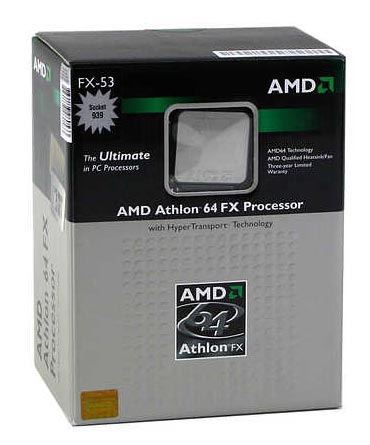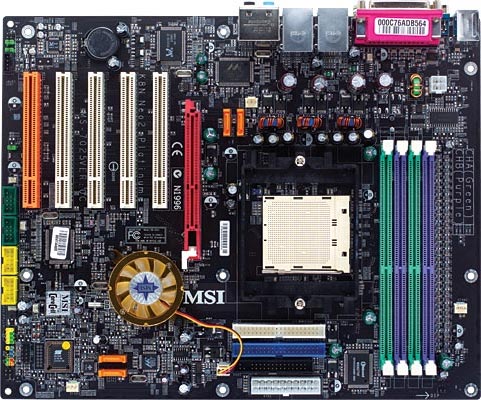Overclocking Buyer's Guide - September 2004
by Wesley Fink on September 17, 2004 12:05 AM EST- Posted in
- Guides
CPU and Motherboard: PERFORMANCE OC Recommendations
CPU: AMD Athlon 64 FX53 (2.4GHz 1024K L2 cache)Motherboard: MSI K8N Neo2 (nForce3 Ultra)
Price: CPU - $850 shipped (Retail). Motherboard - $139 shipped

For Overclockers looking for the best performance possible, it would be tough to recommend anything other than the Athlon 64 FX53. The Athlon 64 is currently the fastest processor that you can buy; the Dual-Channel Socket 939 is the top-performing A64 Socket, and the FX is the fastest 939 processor. The FX also has the distinction of being the only processors that are completely unlocked. That means that you can adjust multipliers both up and down, to obtain the highest possible speed at the fastest DDR400 memory timings, or to obtain the highest FSB that your high speed memory can run or your CPU can reach. Most FX53 that we have tested easily reach 2.6GHz at default voltage with air cooling, and some do even better. This pegs performance at a clock speed that we won't see in a retail CPU until late this year.
While the 3500+ (2.2GHz) can reach similar speeds, it is still multiplier locked at the top (lower multipliers can be selected, though) and the cache is only half of what is found on FX53. The 3800+ runs at the same 2.4GHz with half the cache, but again, the regular Athlon 64 are top-locked, and the small price difference between FX53 and 3800+ makes it difficult to choose the 3800+ over the FX53. What you get in the FX53 is the fastest stock performance currently available among desktop processors, and the ability to reach even higher. AMD does not call the FX series their Enthusiast CPU for nothing. There are no locks to hold you back and the real limit is what the .13 process can do with Athlon 64. Based on how very well the FX53 has performed in our tests in recent reviews, we can hardly wait to test the new 90nm process FX chips that should become available at the end of the year.

After a couple of months of waiting, the MSI K8N Neo2 is now widely available in the retail channel. The K8N Neo2 stood out in our Socket 939 roundup as a top performer and earned the AnandTech Gold Editor's Choice. Perhaps even more important to an overclocker, the K8N Neo2 was the only board in the 939 roundup to match and actually edge ahead of the standout memory performance of the legendary Asus P4C800-E in our overclock tests. The K8N Neo2 actually reached a Clock Frequency of 290 (DDR580) with fast DDR550 memory that we used in our overclock tests. Wherever you can take the FX53, the K8N Neo2 will go - to the limits of your CPU or memory.
While the overclocker will likely turn off most everything when pushing boards to the limit, when the day is done and the system returns to more sedate levels, the K8N Neo2 will continue to impress with a full implementation of the features of the nForce3-250Gb/Ultra including fast on-chip LAN, any-drive RAID that allows IDE and SATA hard drives to be combined in RAID arrays, and an on-chip Firewall. The feature set compares well to any premium Socket 939 on the market and will not disappoint.
For the best overclocking experience, you can count on a working AGP/PCI lock with adjustments from 66 to 100, CPU multipliers from 4X to 20X, HyperTransport adjustments from 1GHz to 200MHz (5x-1x), and CPU frequencies from 200 - 451. You also get a full range of voltage adjustments - vCore to 1.85V, memory voltage to 2.85V, and vAGP to 1.85V. This is even a board for the beginning overclocker, since there are automatic overclocking selections in Core Cell that set everything for you. You just choose the % overclock from 1% to 11% and the board does the rest.
We have never tested a perfect board, but we are impressed by the improvements that MSI has made to the K8N Neo2 with recent BIOS updates. The CPU frequency range has now been raised to 451 from the previous 300. MSI also listened to the suggestions made by AnandTech and other sites, and has added finer 0.5X adjustments for CPU ratios, providing greater control in overclocking the K8N Neo2. There is no real voltage adjustment for HT or chipset voltage, and that would add to the flexibility of this excellent board. In the end, it's hard to complain about a board that does so much so well, particularly when MSI has paid close attention to suggestions for improvement. The MSI reached 290x9 (2610) with fast memory, and for those who prefer raising the ratio, 2652 was an easy 13x204. Since all of these were at near stock voltages, serious overclockers will find ways to get even more from an FX53 on the MSI K8N neo2.
Listed below is part of our RealTime pricing engine, which lists the lowest prices available on the AMD CPUs and motherboards from many different reputable vendors:
If you cannot find the lowest prices on the products that we've recommended on this page, it's because we don't list some of them in our RealTime pricing engine. Until we do, we suggest that you do an independent search online at the various vendors' web sites. Just pick and choose where you want to buy your products by looking for a vendor located under the "Vendor" heading.










31 Comments
View All Comments
MemberSince97 - Friday, September 17, 2004 - link
^^GJ^^ WF...Wesley Fink - Friday, September 17, 2004 - link
#10 - I just checked the ORB for 3DMark2001SE and the highest placing Intel was #10 - the 9 top scores were AMD. 2001SE IS sensitive to CPU speed and memory speed and is useful for comparing CPU's.3DMark2003 is not very sensitive to CPU and Memory, so it is excellent for testing pure video performance. Intel does lead in many of the top ten 3DMark2003 scores, but that is a result of Video card performance since 03 is very video centric. Consider the leads there the result of Intel's chipset prowess in graphics support. Looking at the top 20 it is like 50/50 AMD/Intel in 03.
#17 - The DFI is already for sale in the US. The problem is it is selling out very quickly. Additional production is on it's way to resellers, and DFI is gearing up more production for October.
gnumantsc - Friday, September 17, 2004 - link
Just a little typo in regards to 2 x 74GB Western Digital 74GB Raptor 10,000RPM SATA RAID (148MB Total) Should be 148GB not MB.Unless there is a raid system to make your 2 HDs 1000 times smaller :)
helopilot - Friday, September 17, 2004 - link
Wesley: What an *excellent*, well written article! Full of veryuseful info, specs, opinions and lots of general observations and
tips. I think this is one of the best pieces I've read on a
hardware review site. You must have invested considerable time on
this article!
I especially appreciate the level of detail you've incorporated and
the tables, diagrams, graphics etc. that really help to get the
information across to the reader. You deserve high praise indeed
for this level of tech writing.
Keep up the Good Work!
PolaroidPaul - Friday, September 17, 2004 - link
Great review but one issue that bugs me. I am looking into building a value OC system and it sure seems like the DFI board is a good one. Unfortunately, it is practically vapor ware at the present time.Maybe parts that are not readily available should not be on the recommended list. I hate having to wait for parts to show up in distribution while every article tells me how good the sample was. Tell me about what is comming but don't put it on the list if it does not show up as availalbe on your real time pricing list.
Just my humble opinion!
Illissius - Friday, September 17, 2004 - link
I will repeat the stuff about the value RAM. You say yourself that the A64 isn't as sensitive to memory bandwidth, and the doubling of it with socket 939 only results in 2-9% performance gains. 'Enthusiast' memory is a lot less than twice as fast, so you can extrapolate how much extra performance that would gain, and it makes little sense to spend double on it when that money would be much better spent on a faster processor or video card*.Actually, you should just split the memory into Performance and Value, same as with the processor. Ballistix and EB for Performance, and standard value RAM from someone reputable (eg Corsair Value Select) for the Value. Hell, why not seperate /every/ component into Performance and Value? 9800Pro/6600GT and 6800GT for the video card, WD Raptor and random 120-200GB drives, and so on.
...I'm starting to think that the best thing to do would be to just flat out split the Performance and Value into seperate buyer's guides. They're at least as different as the mid- and high end guides are.
One more thing, and then I'll stop - the HSF has much more significance in the overclocking equation than you seem to be attributing it. You don't need to give it a seperate section, just mentioning a list of the better choices would be nice (afaik, Zalman CNPS7000A-(Al)Cu, Thermalright SLK-947/8U, SP-94/7/8, and XP-90/120, and possibly others), because for the person just getting into the whole overclocking thing, they may not know ;).
* Contrary to a common misconception, you don't need faster memory to overclock the processor. Most boards can lock the memory at stock speeds, or otherwise can use a 5:4 ratio or something.
iversonyin - Friday, September 17, 2004 - link
i would fork out a little more for 2800+ athlon 64 then usin the sempronhes right on the money $20 more, u r better off with 2800+ 64 then sempron
thebluesgnr - Friday, September 17, 2004 - link
#13,it's actually:
X300SE = 9600SE
X300 = 9600
X600PRO = 9600PRO
X600XT = 9600XT
No 9200 in PCIe.
DEMO24 - Friday, September 17, 2004 - link
This is to poster #2. You CAN buy a x300 or x600. its called the 9200 for a x300 and a 9600 for the x600. Theres nothing speical to the x cards below the x800 cuase they are all jsut old cards made to fit PCI-e. A good way for ATI to make money and look good.ksherman - Friday, September 17, 2004 - link
Yippie! someone finally OCed a Sempron! Ive been wondering how well those cheapos would do... Sounds amazing!